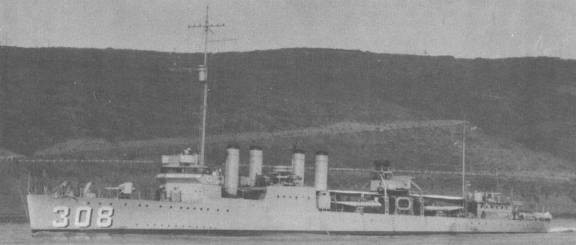William Jones (Destroyer No. 308)

(DD-308: dp. 1,215; l. 314'4-"; b. 30'11- "; dr. 9'4" (mean) ; s. 35 k.; cpl. 122; a. 4 4", 1 3", 12 21" tt.; cl. Clemson)
During the American War of Independence from Great Britain, William Jones, born in 1760 at Philadelphia, Pa., joined a company of volunteer infantry at age 16 and fought in the battles of Trenton and Princeton, N.J. He later served with distinction under Capt. Thomas Truxtun in the Pennsylvania state privateer St. James. During this service, Jones was twice wounded and captured by the British.
From 1790 to 1793, Jones made his home in Charleston, S.C., and sailed in the merchant service before he returned to Philadelphia. After establishing himself as a merchant in the shipping trade, Jones entered politics and ran for office. He subsequently served a term in the House of Representatives during the 7th United States Congress, from 1801 to 1803.
On 12 January 1813, Jones accepted the post of Secretary of the Navy in the cabinet of President James Madison, but he resigned on 2 December 1814 to return to private business. Subsequently appointed collector of customs at Philadelphia in 1827, he held this post until retirement in 1829.
William Jones died on 6 September 1831 at Bethlehem, Pa.
William Jones (Destroyer No. 308) was laid down on 2 October 1918 at San Francisco, Calif., by the Bethlehem Shipbuilding Corp.; launched on 9 April 1919; sponsored by Mrs. Ernest P. McRitchie, the wife of the assistant naval architect at Bethlehem Shipbuilding Corp.; reclassified as DD-308 on 17 July 1920; and commissioned at the Mare Island Navy Yard at Vallejo, Calif., on 30 September 1920, Lt. Comdr. C. E. Rosendahl in temporary command. Lt. Comdr. J. G. B. Gromer took command on 16 November.
Initially assigned to Division 34, Squadron 12, Destroyer Force, Pacific Fleet, William Jones operated off the west coast on duty in connection with the Officers' Engineering School until October 1921, cruising as far north as Seattle and as far south as the waters off the Panama Canal Zone. Assigned to Destroyer Squadrons, Battle Fleet, early in 1922, the destroyer operated with this force over the next seven years. Her operations took the ship up and down the west coast from Puget Sound to the Panama Canal. She took part in fleet maneuvers, exercises in torpedo firing and gunnery, and battle practices. In March 1925, she joined the Fleet for Fleet Problem V during which she screened the Battle Fleet units off Baja Calif., as they carried out maneuvers designed to practice protective screening, seizing and occupying a lightly defended position, and fueling at sea.
Later that summer, William Jones served as one of the ships plane-guarding for the PN-9 flying boat flight to Hawaii. Dogged with misfortune throughout the operation, none of the planes actually flew all the way to Hawaii. One, PN-9 number 3, was forced down by a malfunctioning fuel line. William Jones located her and went to her assistance, later towing her into San Francisco harbor on 1 September. PN-9 number 1, flown by Comdr. John Rodgers, eventually reached Hawaii after an epic voyage in which her intrepid crew stripped the fabric from one wing and used it to fabricate a sail which propelled their fragile craft to Oahu.
From 5 to 15 September, William Jones participated in the Diamond Jubilee celebrations at San Francisco before resuming her operations and exercises off the west coast. She worked along the Pacific coast until 3 and 4 March 1926, when she transited the Panama Canal to take part in maneuvers with the Fleet in the Atlantic. She visited a succession of east coast ports and returned to the west coast on 30 June, when she moored again at San Diego.
William Jones conducted a reserve training cruise to Alaskan waters from 7 to 21 July 1928, pausing atKetchikan, Juneau, and Sitka. After the ship's return to San Diego, she participated in tactical exercises off Balboa and, later, in joint Army-Navy maneuvers off Port Angeles, Wash., in July 1929.
Upon the conclusion of the joint exercises, the destroyer arrived at San Diego late in August 1929 and remained inactive there until decommissioned on 24 May 1930. In accordance with the London treaty for the limitation and reduction of naval armaments, the warship was struck from the Navy list on 13 August 1930 and sold for scrap on 25 February 1932.


